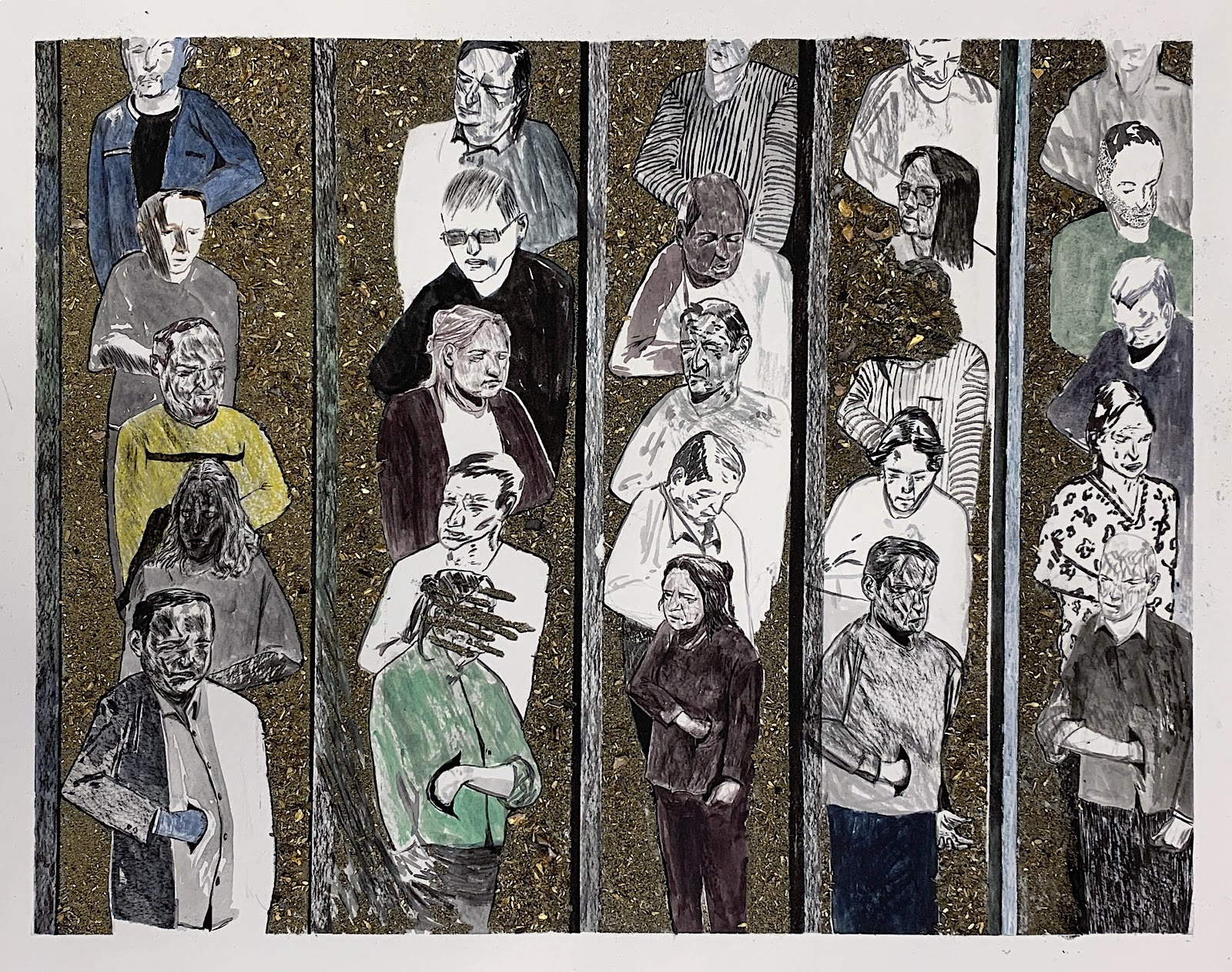I was sitting with my family when the floor of our apartment rocked back and forth. The emergency physician in me had drilled this moment time and again since moving from Baltimore to Beirut eleven years ago, to a city re-built on the ruins of many seismic tragedies. Before I could direct my daughters away from the windows, a loud rumble followed by a deafening explosion blasted through the glass panes, sparing only the one behind us.
For a moment, we all stood frozen there in our living room, absorbing the damage scattered around us.
Glass was everywhere. Pieces the shape of daggers lay across the floors, on the tables and countertops, covering every surface. The dining room seats, where we had been sitting only moments ago, had been sliced through, the white cotton interior bleeding through the slit fabric. Was it another assassination? A bomb? An Israeli air attack? Would more follow? These thoughts raced through my mind as the series of possibilities from memories-past surfaced, stirring a deep nausea that I pushed back.
My husband’s eyes met mine. Naram! Our 12-year-old son had just gone up to Bliss Street for ice cream. A choking sensation gripped my throat as images flashed of him alone, scared, injured. My husband darted out to search for him. Snapping back to the moment, I yelled to my daughters – shoes and OUT! – as I defied my own directives, tiptoeing through the carpet of glass to grab essentials from my room: wallet, medical ID, passports. I was five years old when my family left our mountaintop village of Chemlan in the middle of the night, escaping the destruction of the Israeli army, to the safety of family in Cleveland, Ohio. Passports were important – an awareness imprinted in my mind at an early age.
We rushed down to the sight of my son running towards us. He had no signs of trauma, only the anxiety in his eyes betraying the moment, as they darted back at the fumes behind him. I felt the neck-choke release and an overwhelming urge to hug him. A flurry of phone vibrations interrupted me before I could reach out. Messages from Emergency Medicine faculty started streaming into our WhatsApp group.
First, the personal:
Are you all ok?
Are your children safe?
Then the current reality we all faced:
How’s the ED?
Do you need us for casualties?
I looked up towards our medical center and the mushroom of smoke in its backdrop, emanating from the port that was less than three kilometers away. In my eight years as Chairperson of the largest ED in the country, I had overseen at least a dozen mass casualty responses, enough to know that this one would be different.
Leaving my husband and kids to deal with the debris of our shattered home, I sprinted the 500 meters uphill to the ED, rehearsing the disaster plan our team had developed and refined over the years.
Had security managed to lock-down the ED?
Did disaster carts come up from central store?
Did they start using the disaster registration mode for casualty tracking?
Had reinforcements arrived?
All these needed to be triggered by an alert that had not yet been activated by the team in the ED.
I looked down at my phone. Still nothing. Just the flood of colleague’s messages where private fears and professional duty intersected. Had anyone heard from our colleague whose apartment faced the port? One of our faculty was heading to check on him. My home is destroyed, one reported. My children are scared and crying, another texted. What is happening in the ED? Should we come in?
And the response from the faculty working in the ED that evening: silence. Silence was never a good sign.
My phone flashed. There it was: “Code-D Alert.”
It appeared on my phone as I entered the ED doors where security had already locked down all entrances except the one they were now guarding from behind a steel-barred gate that slid open for incoming casualties only. The bars were new features to our ED, introduced only recently after a crowd had stampeded through our glass entrance during a prior mass casualty response, assaulting staff and residents.
I scanned the ED. Electricity was out except for a few dim emergency lights exposing the shattered glass covering the floor. A door was blown out of its frame. False ceilings hung above a staff member who was helping bandage a patient’s wounds, oblivious to the blood soaking through the back of his own shirt. And everywhere: patients, blood-drenched. They were in the trauma bay, in the waiting areas, in hallways, in rooms filling every section. And through the entrance, they poured in.
I walked towards the Red high acuity zone to assess the area. An intubation of an unresponsive patient was underway in one room. An ED faculty was running a code in the trauma bay. She had recently joined us from Baltimore, the twelfth EM physician we had recruited to help build the specialty, which, as in many countries, was still a new field in Lebanon. This would be her fourth mass casualty response since joining. After this, would she be staying? I wondered.
The image took me back to 2014, when the first physician I had recruited to our ED handed me his resignation. He had joined a couple of years earlier from the US, drawn by the promise of building a new discipline, of returning to his community to help train a league of specialists in EM. Then came the 2013-14 car bombings. The terror of living hostage to an impending explosion and of having to regularly respond to the flood of charred bodies that came through our ED doors, sometime in parts, had become overwhelming. Could the promise of making an impact, which kept many of us grounded through the economic and political turmoil of the past year, survive the Blast?
In the yellow zone area, one of our EM faculty was intubating a child with head trauma. My anxiety settled somewhat when I saw him. He is one of our best, a graduate of our own recently established EM residency program, now a faculty and trusted colleague. The internal waiting area was full of patients splattered with blood, sitting shoulder to shoulder, physical distancing a distant concern. Two of our pediatrics faculty were disinfecting patient wounds, while one of our residents stood by stapling the cleaned-up lacerations. The section was bursting with patients.
I ran back to the entrance past the desperate pleas of wounded patients lining up along the way. My eyes locked with one of our triage nurse’s. We stood across from each other, communicating in silence the horror of what we were witnessing. We had done this before. But we had never experienced this scale of tragedy, never faced this unrelenting flood of blood-drenched casualties.
A new wave of arrivals jolted us back to action as he quickly diverted patients to the external waiting area, expanding into our pre-designated surge section for walking wounded. We had opened three additional surge areas by the end of the night staffed with reinforcements – attendings, nurses, residents and students – who had responded to the ED from across the medical center.
A phone call from a close friend: She was injured, already in the ED. A 20-kilo chandelier had fallen on her head, leaving her with multiple head lacerations, a pounding headache and in shock at what had befallen those around her. She had been by my side through a recent cancer diagnosis and the two subsequent surgeries that followed – she was there when I was wheeled into the operating room both times and, both times, when I woke up.
I ran out of the room to grab supplies with every intention of going back to suture her myself. Before I could turn back, a student grabbed my arm, pulling me to the side of a body in the black area where deceased casualties are lined up for the morgue. The body was of a male around my age, in his mid-forties, no clear sign of trauma, just a coat of ashen dust from head to toe. Three leads on his chest denoted the resuscitation that had been attempted and called off. The patient’s elderly father was holding his hand. “He’s warm…please do something!” He pushed on his chest mimicking compressions. I checked for a femoral pulse, remembering stories of bodies prematurely pronounced dead during the civil war, only to be found later alive, chest rising. No femoral pulse was palpable. I felt for the carotids. Nothing.
“I am sorry sir, Allah yerhamo.”
“He has two children,” he implored.
I stood paralyzed for a moment. Resources in mass casualty needed to be saved for salvageable patients. One cycle, I thought. One cycle would allow this father to mourn in peace, knowing that we, and he, had tried everything. Before I could make the call, a nurse pulled me to the trail of stretchers lining up in the hallways, away from the father whose face would visit my dreams for the next month with the same desperate plea.
By now, the issue was no longer of finding places to see patients, it was the gridlock forming from patients who clearly needed inpatient beds. Eighty-seven admissions had piled up in our 40-bed ED. We needed beds and had no time for electronically entered admission requests and processes that now stood to paralyze us. I ran through the list of open hospital beds with the admitting team. Some were un-usable, damaged by the blast. The remaining, we launched patients up to, without the usual safety checks that stand between transitions of care: No handover, no patient names, no medication lists. Just an army of residents led by inpatient attendings who had gone up to start receiving the patients.
I went back to see my friend. A resident was placing the last stitch. I put down the suturing set I no longer needed, heavy with regret. “I have a terrible headache. Do I need a CT scan?” Under normal circumstances, yes, I thought. Then, visualizing the trail of stretchers with unresponsive patients waiting for imaging, I reassured her past my own doubts, “No, you’ll be okay.” I promised to call her the next day and walked out, my head in turmoil with the decision I had just made.
“Crisis standards of care” is a term thrown lightly across textbooks on mass casualty response, referencing an accepted and expected deviation from routine practice standards when resources become strained. Little, however, is mentioned of the burden of imperfect decisions with inevitable outcome implications on the physicians who have to make them. The weight of deciding who gets the last ventilator and who is left to struggle through without the protection of a secure airway; the guilt that comes with deciding who gets the last bed and who goes home – tendons severed, arms limp – to return for delayed care; the sickening feeling of betrayed trust that wells up with deciding who gets to line up for the CT queue and who is told to go home to wait it out. What if she has a brain bleed? Would it leave her with deficits? Would she forgive me? Would her family forgive me? The tormenting guilt, self-doubt and disorienting moral injury that gnawingly linger when all else has passed.
I recognized a voice from a nearby room. It was one of our EM faculty suturing the last of around seven lacerations studding a four-year-old’s face. The child was staring up calmly, no papoose, no sedation, strangely quiet. Then it hit me: It was his son. I looked back up at my colleague, his own face a treasure hunt map, with lacerations partially closed across his forehead and blood staining his shirt. His wife, holding their son’s hand and soothing him softly, was also drenched in blood. He was the faculty whose apartment faced the explosion. They were at home when it happened. He was now here, in our ED, with none of us by his side. “Can I take over for you?” I asked, too late. This was the person who started our EM residency program, the person who led the founding battles of the specialty with us. How did he slip through our entrance without any of us coming to his help? Would he be staying in Lebanon, I wondered?
Drenched in sweat from running back and forth under the impermeable gown and nauseated by the metallic smell of mopped up blood that still managed to permeate my N95 mask, I headed back to triage. The security guards were now pushing back against the crowd that was trying to barge through. The crowd had become loud with anger, strong with resolve, insisting on names of missing loved ones. The steel bars were now rocking back and forth, hinges coming undone. They wanted names we did not have. Our registration team – responsible for identifying patients – was down to skeleton staffing, many dismissed a few weeks prior by cuts meant to save our financially struggling medical center. Our ED medical director recognized the gravity of this shortcoming and took off with our case manager to the inpatient floors to fill the gap. Twenty minutes later, he stood before the crowd announcing one name after the other: allaying many and leaving others whose loved ones were still missing in even deeper yet more subdued despair.
By midnight, the activity had shifted out of the ED, into the operating rooms, and onto the inpatient floors. We had seen around 360 casualties that night, a count that would increase to 700 by the end of the week, at our ED alone. I left around 5:30 a.m. Usually the beautiful walk back to my home is one filled with the aroma of zaatar from nearby bakeries and the sounds of chirping birds waking up in one of the most vibrant cities. That day, I walked back to the silence of a city mourning. Lives were lost, others were still missing. Homes were damaged, with thousands displaced. A pandemic, once contained, was now unleashed.
Across the city that night, medical teams had put aside their own loss and fears, gallantly hurling themselves into action. Demolished hospitals were evacuated. Flooded EDs were emptied. Operating rooms ran without reprieve. Decisions were made amidst unimaginable constraints. Physical wounds were closed, and moral ones opened.
Today, almost six months post-Blast, the scars on my colleagues’ faces are barely noticeable. The displaced doors of our ED are back up on their hinges. The glass panes of my house have been replaced. Our passports are tucked back in the reachable safety of my bedroom drawers. While some wounds heal, others remain painfully visible. Resignations sit on my desk, leaving the line of medical teams facing the now raging pandemic thinned out and weary. For many, distance is the path to recovery. For others, it is clawing on to the promise of meaningful service in the land they were forced to leave once before.

Eveline Hitti
Eveline Hitti is an Associate Professor in Clinical Emergency Medicine and Chairperson of the Department of Emergency Medicine at AUB. She graduated with an M.D. degree from Johns Hopkins University in 2002, where she also completed her residency training in Emergency Medicine. After spending four years at Medstar Health and completing her MBA at the Johns Hopkins Carey Business School, Dr. Hitti joined AUB in 2009 where she has focused her effort on advancing the field of emergency medicine.




